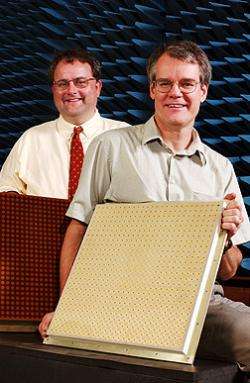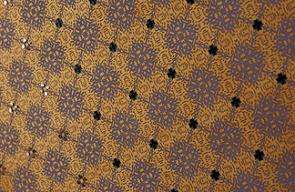100-to-1 Bandwidth: New Planar Design Allows Fabrication of Ultra Wideband Phased Array Antennas

By taking advantage of a phenomenon that earlier designers had struggled to avoid, engineers at the Georgia Tech Research Institute (GTRI) have developed a new approach to phased-array antenna design that could allow a single ultra-wideband device to do the job of five conventional antennas.
The “Fragmented Aperture Antenna,” a computer-designed planar system, has already demonstrated a 33-to-1 bandwidth – well beyond the 10-to-1 ratio achieved by conventional designs. The researchers believe they can extend that range to at least 100-to-1 for use in radar and communication applications.
“Phased array antennas take up space, and if you must have a different antenna for every function – communications, radar and other tasks – the space required can be considerable,” noted Paul Friederich, a principal research engineer in GTRI’s Signature Technology Lab (STL). “On any military platform, space is at a premium. Our antenna can replace five conventional antennas, which would reduce the weight and volume required for antennas.”

The GTRI ultra-wideband antenna would also have applications in most Department of Defense agencies. Current ships must carry dozens of antennas – a problem for all ships, especially submarines. Aircraft have limited surface area for antennas, with weight always a concern. Ground vehicles and even individual soldiers could benefit from reducing the number of antennas they must carry, Friederich noted.
Because it is flat and can be conformed to surfaces, the new antenna design could also have commercial applications, Friederich noted.
Key to the new GTRI design was taking advantage of electronic interaction between antenna elements known as “mutual coupling.” For years, antenna designers had been taught to minimize this interaction. But with their detailed computer modeling, the GTRI engineers realized they could take advantage of it by electrically connecting the elements.
“Instead of trying to avoid mutual coupling, we designed it into the antenna where it actually provides a lot of benefits – including allowing us to have an extremely wide bandwidth,” explained Jim Maloney, an STL principal research engineer. “What everybody used to avoid was actually the silver bullet that makes this work.”
The 33-to-1 antennas are flat and include three layers of metal foil fabricated in computer-designed patterns using printed circuit board technology. A prototype that works down to 300 MHz is16 inches square and about three inches thick – providing a substantial size, weight and volume savings over conventional “egg crate” antennas.
“The advantage of this technology is that it is manufactured using planar printed circuit boards,” Maloney said. “We just laminate them together so they are flat. The conformal nature of these antennas also provides an advantage.”
Beyond their circuitry pattern, the antennas also need a backplane to reflect electromagnetic energy – and protect the electronic control equipment behind the antenna. The new antenna also relies on computer-designed innovations there: a “broadband screen backplane” made up of foam and partially-conductive films.
“This is a materials sandwich that we designed using our computer modeling codes,” explained Friederich. “We had to make a new backplane that would be compatible with the extreme bandwidths so it wouldn’t degrade the antenna performance, so we developed a laminate of foam and partially-conducting layers to do that in an optimal way.”
Beyond the technical issues they had to overcome, the researchers also faced skepticism from their colleagues – and an antenna test system that was designed for conventional devices. For instance, they had to evaluate their 33-to-1 device in three different antenna test facilities to cover the entire frequency range.
GTRI has been working on the ultra wideband antenna for nearly a decade, building new technology on top of detailed computer models.
“Nobody could really study the mutual coupling effects until computers became good enough to evaluate what would happen when you moved elements around and changed their shapes in the presence of other elements,” said Maloney. “One of our strengths is an ability to do very detailed and accurate numerical models of antenna performance. We can determine how antennas are going to perform without having to build them.”
The new design will reduce antenna volume and weight. By simplifying construction of the radiating structures, the antenna electronics become the driver of the overall cost. Long term savings there will depend on advances in microelectronics fabrication, Friederich cautioned.
Beyond potential use on military aircraft, ships and ground vehicles, the technology developed in GTRI could also have applications for devices that would not need broad bandwidth – such as wearable antennas that could be incorporated into military uniforms or even tents. The conformal nature of the devices could also open up commercial applications, though cost could be an obstacle.
“Now that we have shown the antenna works, we are in a consolidation phase of work in which we’re trying to figure out which bandwidths make sense for particular applications, and we working with corporate partners to design the electronics that will be needed,” added Friederich. “It’s just a matter of time before we see these antennas begin appearing on military platforms.”
Beyond Friederich and Maloney, development of the antenna has involved Doug Denison, Lynn Fountain, Brad Baker, Eric Kuster, Stephen Blalock, James Fraley and a number of co-op and graduate students.
Source: Georgia Institute of Technology





















